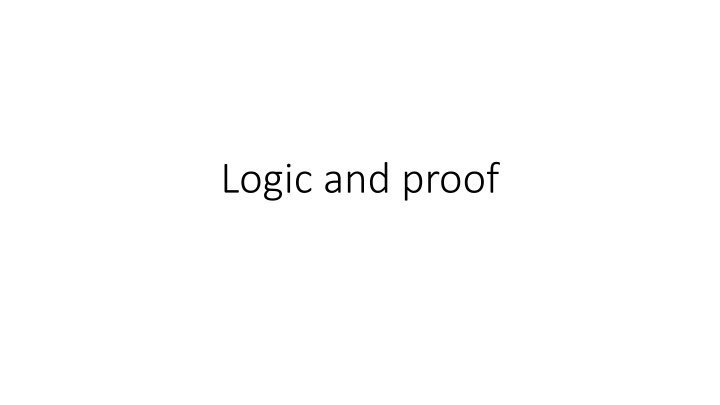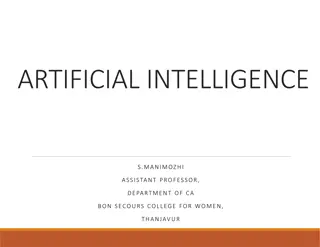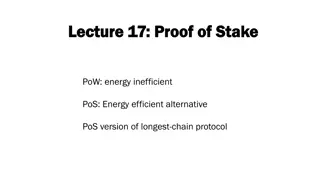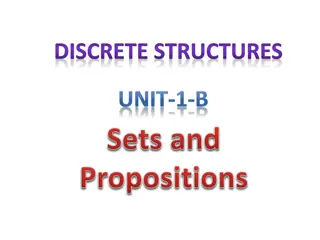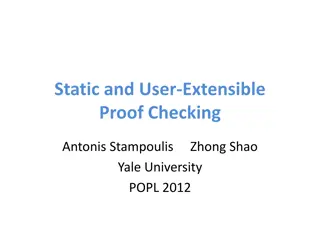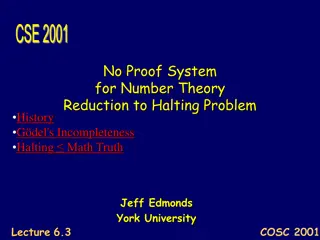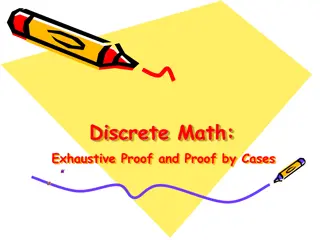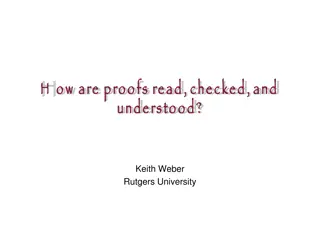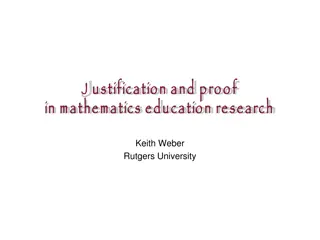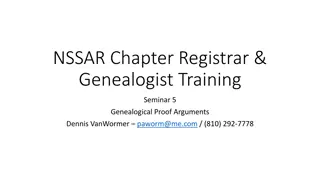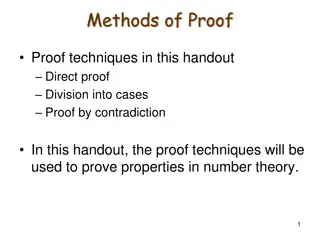Insights into Logic and Proof: A Historical Journey
Delve into the historical timeline of logic and proof, from ancient Egyptian mathematical activities to modern advancements in computational proof assistants. Discover the evolution of symbolic logic and the development of proof systems like natural deduction. Explore the significance of logical expressions in computer science and the quest for reliable truth through adopted rules of inference.
Download Presentation

Please find below an Image/Link to download the presentation.
The content on the website is provided AS IS for your information and personal use only. It may not be sold, licensed, or shared on other websites without obtaining consent from the author.If you encounter any issues during the download, it is possible that the publisher has removed the file from their server.
You are allowed to download the files provided on this website for personal or commercial use, subject to the condition that they are used lawfully. All files are the property of their respective owners.
The content on the website is provided AS IS for your information and personal use only. It may not be sold, licensed, or shared on other websites without obtaining consent from the author.
E N D
Presentation Transcript
Resources Logic and Proof. 1. Introduction Logic and Proof. 2. Propositional Logic Some parts of Logic and Proof. 3. Natural Deduction for Propositional Logic
Some points from history A written evidence of mathematical activity in Egypt around 3000 BC The birth of mathematics is located in ancient Greece around 6thcentury BC, where deductive proof (by Thales of Miletus) was first introduced it is not only important to know something but also to know how we know it (Aristotle) Prior Analytics of Aristotle from around 350 BC Elements of Euclid from around 300 BC Leibnitz in 17thproposed the design of a characteristica universalis (a universal symbolic language) and a calculus ratiocinatur (a calculus to express the precise rules of reasoning) 19thcentury this universal symbolic language is being developed by Boole, Frege, Peirce, Schr der and others 20thcentury their efforts blossomed into the field of mathematical logic. The end of century computational proof assistants allowed to make complete formalization feasible
A symbolic logic Provides an idealized model of mathematical language and proof Aristotle, Leibnitz, Boole, Frege, Peirce, Schroeder The goal: to specify a language and rules of inference that enable us to get at the truth in a reliable way We choose denote objects and concepts that have a fixed meaning Adopted rules of inference enable us to draw true conclusions from true hypotheses
What is used in this textbook As a proof system a version of natural deduction, introduced by Gerhard Gentzen in the 1930s to model informal styles of arguments The fundamental unit of judgement is the assertion that a statement, A, follows from a finite set of hypotheses, : A If and are two finite sets of hypotheses, , is written for the union of these two sets (the set consisting of all the hypotheses in each) The conjunction symbol can be expressed as:
The semantic point of view to logic Logic is not so much a language for asserting truth, but a language which expressions can be true or false depending on how we interpret the symbols that are allowed to vary This view is important in computer science: The use of logical expressions to select entries from a database Specifying properties of hardware and software systems
Malice and Alice (from George J. Summers Logical Deduction Puzzles)
Older Not victim s twin Younger
What you may notice if you work on the puzzle It is helpful to draw a diagram It is helpful to be systematic about searching for an answer There are finitely many possible states of affairs The question seems to presuppose that there is a unique answer to the question there is only one person who can possibly be the killer
Man and Woman in the bar, Killer and Victim on the beach, Child alone Either Alice s husband was in the bar and Alice was on the beach, or Alice was in the bar and Alice s husband was on the beach
Older Not victim s twin Younger
Older Not victim s twin Younger
Older Not victim s twin Younger
? Older Not victim s twin Younger
? Older Not victim s twin Younger
? Older Not victim s twin Younger
Older Not victim s twin Younger
Older Not victim s twin Younger
Lets prove it by using the methods of symbolic logic A, B, C variables that stand for fundamental statements or propositions , , , for and , or The inscription is used to indicate that statement C is a logical consequence of A and B
Implication, implication elimination (modus ponens) Tells us how to use an implication in an argument If Alice was in the bar, Alice was with her brother or her son. Alice was in the bar. Therefore, Alice was with her brother or son.
Implication 2 a form of hypothetical reasoning Suppose Alice s husband was in the bar. Then Then Then Alice or her brother was the victim. Thus, if Alice s husband was in the bar, then Alice or her brother was the victim.
Conjunction Alice s brother was the victim. Alice s husband was the killer. Therefore, Alice s brother was the victim and Alice s husband was the killer. Alice s husband was in the bar and Alice was on the beach. So, Alice s husband was in the bar. Alice s husband was in the bar and Alice was on the beach. So Alice was on the beach.
Negation and Falsity (ex falso sequitur quodlibet) - introduction Suppose Alice s husband was in the bar. This situation is impossible. Therefore Alice s husband was not in the bar.
Negation and Falsity (ex falso sequitur quodlibet) - elimination The killer was Alice s husband, and the victim was the child he was with. So, the killer was not younger than his victim. But according to (6), the killer was younger than his victim. This situation is impossible. "this is contradiction", "this is impossible , false for true
Disjunction Alice s daughter was alone at the time of the murder. Therefore, either Alice s daughter was alone at the time of the murder, or Alice s son was alone at the time of the murder. the l and r stand for left and right
Disjunction elimination We had established that either Alice s brother or her son was in the bar, and we wanted to argue for the conclusion that her husband was on the beach Either Alice s brother was in the bar, or Alice s son was in the bar. Suppose, in the first case, that her brother was in the bar. Then Therefore, her husband was on the beach. On the other hand, suppose her son was in the bar. In that case, Therefore, in this case also, her husband was on the beach. Either way, we have established that her husband was on the beach.
Disjunction elimination - 2 Either Alice s husband was in the bar, or Alice was in the bar. Alice s husband was not in the bar. So, Alice was in the bar.
If and only if I claim that Alice is in the bar if and only if Alice s husband is on the beach. To see this, first suppose that Alice is in the bar. Then Hence Alice s husband is on the beach. Conversely, suppose Alice s husband is on the beach. Then Hence Alice is in the bar.
Elimination rules for iff left rule: Alice is in the bar if and only if Alice s husband is on the beach. Alice is in the bar. Hence, Alice s husband is on the beach. right rule Alice is in the bar if and only if Alice s husband is on the beach. Alice s husband is on the beach. Hence, Alice is in the bar.
Proof by contradiction (reductio ad absurdum) Suppose Alice s husband was not on the beach. This situation is impossible. Therefore, Alice s husband was on the beach.
Solution on the language of symbolic logic A: Husband was in the bar B: Alice was on the beach C: Alice was in the bar D: Husband was on the beach E: Daughter was in the bar F: Son was alone G: Husband was in the beach H: Alice was the victim I: Alice was the killer J: Brother was the victim K: Brother was the killer (A B) (C D) (A B) (A E) F (B G) (H K) (I J)
Exercises: Murder in the Family by George J. Summers Murder occurred one evening in the home of a father and mother and their son and daughter. One member of the family murdered another member, the third member witnessed the crime, and the fourth member was an accessory after the fact. 1. The accessory and the witness were of opposite sex. 2. The oldest member and the witness were of opposite sex. 3. The youngest member and the victim were of opposite sex. 4. The accessory was older than the victim. 5. The father was the oldest member. 6. The murderer was not the youngest member. 7. Which of the four father, mother, son, or daughter was the murderer? Solve this puzzle, and write a clear argument to establish that your answer is correct.
Natural deduction for propositional logic Deductive approach an inference is valid if it can be justified by fundamental rules of reasoning that reflect the meaning of the logical terms involved Natural deduction every proof is a proof from hypotheses; in any proof there is a finite set of hypotheses {B,C, } and a conclusion A. The proof shows that A follows from B,C, Proofs are built by putting together smaller proofs, according to the rules
Forward and backward reasoning Proofs are constructed by putting smaller proofs together to obtain bigger ones When we read (natural deduction) proofs, we often read them backward. We look at the bottom to see what is being proved. Then we consider the rule that is used to prove it and see what premises the rule demands. Then we look to see how those claims are proved and so on. When we construct a natural deduction proof, we typically work backward as well: we start with the claim we are trying to prove, put that at the bottom and look for rules to apply
Forward and backward reasoning Working backward may be not possible. Ex., we are left with a goal that is a single propositional variable A. The general heuristic for proving theorems in natural deduction: 1. Start by working backward from the conclusion, using the introduction rules. For example, if you are trying to prove a statement of the form A B, add A to your list of hypotheses and try to derive B. If you are trying to prove a statement of the form A B, use the and-introduction rule to reduce your task to proving A, and then proving B. 2. When you have run out things to do in the first step, use elimination rules to work forward. If you have hypotheses A B and A, apply modus ponens to derive B. If you have a hypothesis A B, use or-elimination to split on cases, considering A in one case and B in the other.
Every hypothesis has a scope In natural deduction proofs every hypothesis has a scope. There are only certain points in the proof where an assumption is available for use from the point where it is assumed until the point where it is canceled.
